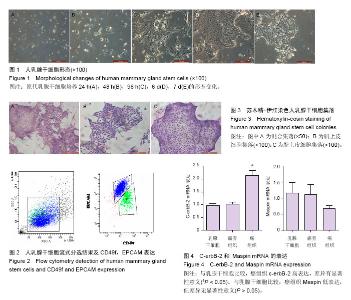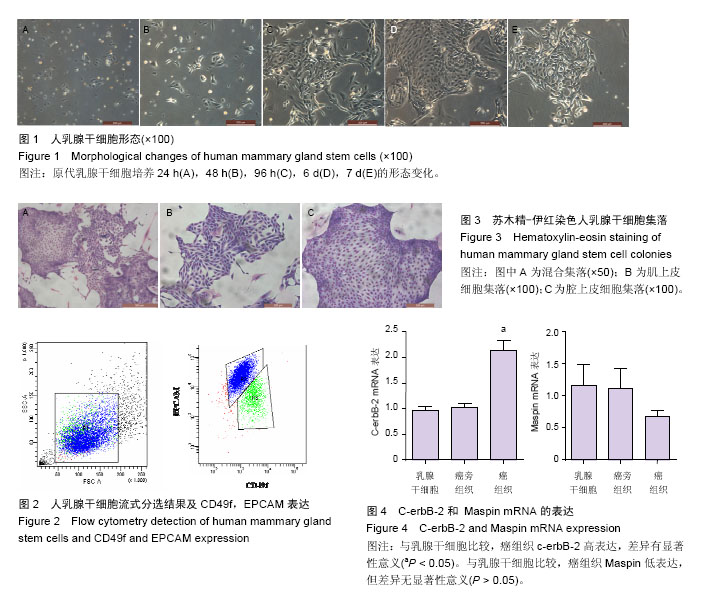| [1] Russo J, Russo IH. Development of the human breast. Maturitas. 2004;49(1):2-15.
[2] Reya T, Morrison SJ, Clarke MF, et al. Stem cells, cancer, and cancer stem cells. Nature. 2001;414(6859):105-111.
[3] Sreekumar A, Roarty K, Rosen JM. The mammary stem cell hierarchy: a looking glass into heterogeneous breast cancer landscapes. Endocr Relat Cancer. 2015; 22(6):T161-176.
[4] Ljujic B, Milovanovic M, Volarevic V, et al. Human mesenchymal stem cells creating an immunosuppressive environment and promote breast cancer in mice. Sci Rep. 2013;3:2298.
[5] Lim E, Vaillant F, Wu D, et al. Aberrant luminal progenitors as the candidate target population for basal tumor development in BRCA1 mutation carriers. Nat Med. 2009;15(8):907-913.
[6] Perruchot MH, Arévalo-Turrubiarte M, Dufreneix F, et al. Mammary Epithelial Cell Hierarchy in the Dairy Cow Throughout Lactation. Stem Cells Dev. 2016;25(19): 1407-1418.
[7] Ginestier C, Hur MH, Charafe-Jauffret E, et al. ALDH1 is a marker of normal and malignant human mammary stem cells and a predictor of poor clinical outcome. Cell Stem Cell. 2007;1(5):555-567.
[8] Liu JF, Xia P, Hu WQ, et al. Aldehyde dehydrogenase 1 expression correlates with clinicopathologic features of patients with breast cancer: a meta-analysis. Int J Clin Exp Med. 2015;8(6):8425-8432.
[9] Liu S, Dontu G, Mantle ID, et al. Hedgehog signaling and Bmi-1 regulate self-renewal of normal and malignant human mammary stem cells. Cancer Res. 2006;66(12):6063-6071.
[10] Chepko G, Smith GH. Mammary epithelial stem cells: our current understanding. J Mammary Gland Biol Neoplasia. 1999;4(1):35-52.
[11] Welm BE, Tepera SB, Venezia T, et al. Sca-1(pos) cells in the mouse mammary gland represent an enriched progenitor cell population. Dev Biol. 2002;245(1): 42-56.
[12] Shackleton M, Vaillant F, Simpson KJ, et al. Generation of a functional mammary gland from a single stem cell. Nature. 2006;439(7072):84-88.
[13] Stingl J, Eirew P, Ricketson I, et al. Purification and unique properties of mammary epithelial stem cells. Nature. 2006;439(7079):993-997.
[14] Sani M, Hosseini SM, Salmannejad M, et al. Origins of the breast milk-derived cells; an endeavor to find the cell sources. Cell Biol Int. 2015;39(5):611-618.
[15] Sleeman KE, Kendrick H, Robertson D, et al. Dissociation of estrogen receptor expression and in vivo stem cell activity in the mammary gland. J Cell Biol. 2007;176(1):19-26.
[16] Smith GH. Experimental mammary epithelial morphogenesis in an in vivo model: evidence for distinct cellular progenitors of the ductal and lobular phenotype. Breast Cancer Res Treat. 1996;39(1): 21-31.
[17] Guo W, Keckesova Z, Donaher JL, et al. Slug and Sox9 cooperatively determine the mammary stem cell state. Cell. 2012 2;148(5):1015-1028.
[18] Huo Y, Macara IG. The Par3-like polarity protein Par3L is essential for mammary stem cell maintenance. Nat Cell Biol. 2014;16(6):529-537.
[19] Joshi PA, Jackson HW, Beristain AG, et al. Progesterone induces adult mammary stem cell expansion. Nature. 20100;465(7299):803-807.
[20] Milani ES, Brinkhaus H, Dueggeli R, et al. Protein tyrosine phosphatase 1B restrains mammary alveologenesis and secretory differentiation. Development. 2013;140(1):117-125.
[21] Prater M, Shehata M, Watson CJ, et al. Enzymatic dissociation, flow cytometric analysis, and culture of normal mouse mammary tissue. Methods Mol Biol. 2013;946:395-409.
[22] Tao L, Roberts AL, Dunphy KA, et al. Repression of mammary stem/progenitor cells by p53 is mediated by Notch and separable from apoptotic activity. Stem Cells. 2011;29(1):119-127.
[23] Shaw FL, Harrison H, Spence K, et al. A detailed mammosphere assay protocol for the quantification of breast stem cell activity. J Mammary Gland Biol Neoplasia. 2012;17(2):111-117.
[24] Gao H, Dong Q, Chen Y, et al. Murine mammary stem/progenitor cell isolation: Different method matters. Springerplus. 2016;5:140.
[25] Linnemann JR, Miura H, Meixner LK, et al. Quantification of regenerative potential in primary human mammary epithelial cells. Development. 2015; 142(18):3239-3251.
[26] Bombonati A, Sgroi DC. The molecular pathology of breast cancer progression. J Pathol. 2011;223(2): 307-317.
[27] Cowell CF, Weigelt B, Sakr RA, et al. Progression from ductal carcinoma in situ to invasive breast cancer: revisited. Mol Oncol. 2013;7(5):859-869.
[28] Silva-Escobedo JG, Sanchez-Monroy V, Rojas-Lopez M, et al. c-erbB-2 as a possible target for the use of magnetic nanoparticles in breast cancer cells. IEEE Trans Nanobioscience. 2014;13(3):300-307.
[29] Sinha AK, Ghosh R. In reply: maspin and it's evolving role in tumor progression in systemic malignancies. Breast Cancer. 2014;21(2):250.
[30] Machowska M, Wachowicz K, Sopel M, et al. Nuclear location of tumor suppressor protein maspin inhibits proliferation of breast cancer cells without affecting proliferation of normal epithelial cells. BMC Cancer. 2014;14:142. |

